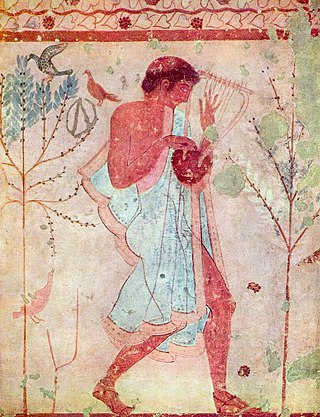
Lars Tolumnius was the most famous king of the wealthy Etruscan city-state of Veii. He is best remembered for instigating, and decisively losing, a war with the neighboring Roman Republic.
Marcus Postumius Albinus Regillensis was an ancient Roman politician belonging to the patrician Postumia gens. His father and grandfather were both named Aulus, possibly identifying his father or grandfather as Aulus Postumius Albus Regillensis, consul in 464 BC. Publius Postumius Albinus Regillensis, consular tribune in 414 BC, was most likely his brother. Postumius relationship to later Postumii Albini remains unknown as filiations are missing from the consular tribunes and consuls of 397, 394 and 334 BC.
The Roman–Etruscan Wars, also known as the Etruscan Wars or the Etruscan–Roman Wars, were a series of wars fought between ancient Rome and the Etruscans. Information about many of the wars is limited, particularly those in the early parts of Rome's history, and in large part is known from ancient texts alone. The conquest of Etruria was completed in 265–264 BC.
Postumus Aebutius Helva Cornicen was consul at Rome in 442 BC, and magister equitum in 435.
Lucius Furius Medullinus, of the patrician gens Furia, was a politician and general of the Roman Republic who was consul twice and Consular Tribune seven times.

Aulus Cornelius Cossus was a Roman general in the early Republic. He is famous for being the second Roman, after Romulus, to be awarded the spolia opima, Rome's highest military honour, for killing the commander of an enemy army in single combat. Only three Romans ever achieved this feat, but a fourth winner was officially denied the honour by a jealous Consul Caesar Octavianus who insisted the honour was limited exclusively to Roman commanders. Cornelius Cossus proved otherwise.
The Roman–Sabine wars were a series of wars during the early expansion of ancient Rome in central Italy against their northern neighbours, the Sabines. It is commonly accepted that the events pre-dating the Roman Republic in 509 BC are semi-legendary in nature.
The Roman-Aequian wars were a series of wars during the early expansion of ancient Rome in central Italy against their eastern neighbours, the Aequi.
Lucius Julius Iullus was a member of the ancient patrician gens Julia. He was one of the consular tribunes of 438 BC, magister equitum in 431, and consul in 430 BC.
Lucius Sergius Fidenas was a Roman politician during the 5th century BC, and was elected consul in 437 and 429 BC. In 433, 424, and 418 BC he was military tribune with consular power.
Quintus Servilius Priscus Fidenas was a political figure and military leader in the Roman Republic who served as dictator in 435 BC and in 418 BC.
Marcus Fabius Vibulanus was consul of the Roman republic in 442 BC and consular tribune in 433 BC.
Lucius Quinctius Cincinnatus was a consular tribune of the Roman republic in 438, 425, 420 BC and possibly consul in 428 BC.
Proculus Verginius Tricostus was a consul of the Roman Republic in 435 BC. He was possibly re-elected as consul in 434 BC.
Titus Quinctius PoenusCincinnatus was a consul of the Roman Republic in 431 and 428 BC and a consular tribune in 426 BC. He might have been consular tribune again in 420 BC.
Hostus Lucretius Tricipitinus was a consul of the Roman republic in 429 BC.
Gaius Valerius Potitus Volusus was a consul in 410 BC and consular tribune in 415, 407 and 404 BC of the Roman Republic.
Quintus Quinctius Cincinnatus was a consular tribune in 415 and 405 BC of the Roman Republic.
Manius Aemilius Mamercinus was a three-time consular tribune, in 405, 403 and 401 and also consul in 410 BC, of the Roman Republic.
Gnaeus Cornelius Cossus was a consular tribune of the Roman Republic in 406, 404 and 401 BC.



